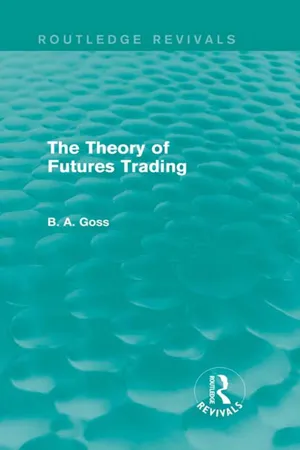![]()
1
The beginnings: Keynes, Hicks and Kaldor
Keynes
In his Treatise on Money (London, 1930, vol. 2, p. 142) Keynes says that in an organized market for raw materials there are, at any one time, two price quotations. One is for immediate delivery (the spot price); the other is for delivery at a later date, say six months in the future (the forward price). For a producer whose period of production is six months, it is the latter price which is important in determining the extent of his operations. It may appear that it is the price which the producer expects in six months which is important in this respect, but Keynes's point is that he can sell the product forward even before the productive process is begun, and thereby hedge against the risk that the price will fall during the period of production.
This implies something about his attitude to risk; it assumes that he prefers certainty, Keynes goes on to say: ‘If the futures price shows a profit on his cost of production he can go ahead and produce, selling his product forward, and running no risk.’
Keynes then examines three market situations. In the ‘normal’ case, where supply equals demand and no change in supply or demand conditions is expected, the spot price and the expected spot price coincide. Then the spot price must exceed the forward price (backwardation) by the amount which the producer is willing to sacrifice to hedge himself against the risk of a price fall. That is, the spot price includes a risk premium, which the forward price does not (ibid., p. 143). So the normal case is one of backwardation, and the amount of the ‘normal backwardation’ is the hedger's marginal risk premium.
If there is a shortage of supply which can be remedied in six months, then the spot price may rise above the forward price to an extent which is limited by the willingness of the buyer to pay the higher spot price rather than postpone his purchases (ibid.). That is, there will be an abnormal backwardation. On this argument, if the shortage of supply could not be remedied in six months, one would expect the forward price to rise also, especially if the spot price was expected to keep on rising.
When there are surplus stocks, Keynes argues that a backwardation cannot exist (ibid., p. 144). For if there were a backwardation it would pay the stockholder to sell the stocks spot and buy them back forward, and so escape the carrying costs. The fact that he would wish to buy them back implies that his expected spot price exceeds both the spot and forward prices (or that he is committed to using the stocks at a later date); see p. 19.
So if surplus stocks exist F (the forward price) must exceed the spot price S (contango) and the contango must equal the storage, depreciation and interest charges of carrying the stocks. The reason for this is evidently that if the contango were less than this amount it would be profitable to sell the stocks spot and buy them back forward and so escape part of the carrying costs. Presumably this would continue until S had fallen to the required level. If the contango were greater than this amount it would pay to buy stocks spot and sell them forward and so make a riskless profit. This would continue until the contango was equal to the carrying costs (ibid.). So the equilibrium contango, as it were, according to Keynes, equals the carrying costs of the stock.
The terms ‘surplus stocks’ and ‘shortage of supply’ presumably indicate that the spot price is not in equilibrium, for if it were, the stocks would not be surplus (or short).
The existence of a contango, however, Keynes points out, does not mean that the producer can hedge without paying a risk premium as a price for certainty. In fact the price is likely to have risen because of the additional uncertainty due to the surplus stocks. That is, the forward price must be less than the expected spot price by at least the amount of the normal backwardation. This, however, seems to imply some uniformity in expectations.1 For if the expected spot price of a particular trader were less than the forward price he would be paying a negative price for certainty.
So in Keynes's theory the hedger is a seller whose risk is that of a price fall. He makes his position certain by selling his product forward, and for the privilege of certainty he pays a particular price.
The hedger qua hedger, although he may have price expectations, does not act on them. Otherwise he would hedge when he expects the price to fall, and not when he expects it to rise. Therefore expectations do not enter into his hedging activities, although, as we have seen above, the use of price expectations is implied in some actions.
Suppose, ...
